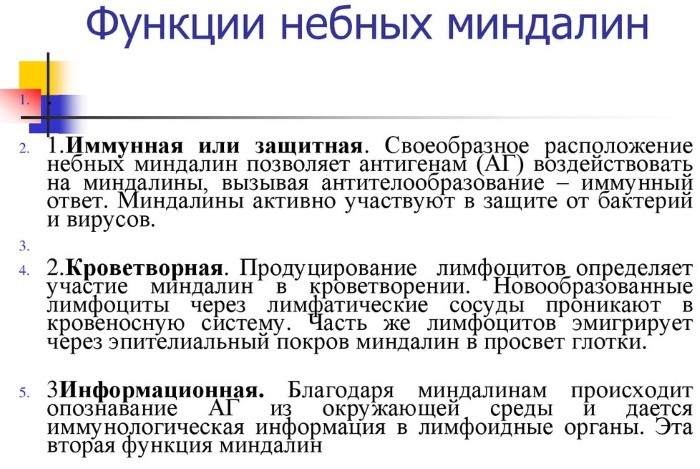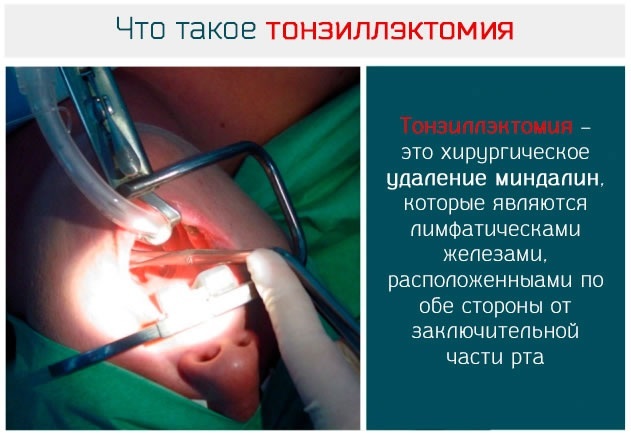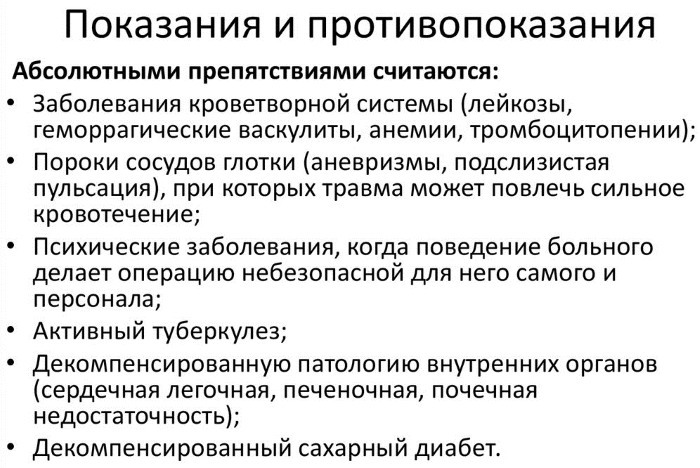Content
- Functions of the tonsils
- How necessary is the removal of tonsils in children and adults?
- Contraindications
- Negative consequences
- Types of complications after removal
- Local-regional complications
- Generalized complications
- Cons of tonsil removal
- Infection protection
- Cancer protection
- Possible complications
- Surgery for children and adults
- Videos about tonsillectomy
The most controversial procedure in the practice of otolaryngologists is removal of palatine tonsils (tonsillectomy). Feedback from patients and specialists is multidirectional. With the development of surgical technologies, the incidence of negative consequences of surgery has decreased by 3 times.
Functions of the tonsils
The organ is an accumulation of lymphoepithelial tissues that make up the elastic pharyngeal ring. The anatomical structure of the tonsils is porous. The main functions of the organ are barrier and immunogenic.
The body of the tonsils is speckled with peculiar gaps. Microscopic cavities act as a trap for infectious agents and foreign elements entering the respiratory canals during breathing. Lacunae provide the barrier function of the tonsils.

The immunogenic value of the organ lies in the presence of special follicular elements in which lymphocytic cells mature. They neutralize bacterial and viral agents that penetrate the dental and nasopharyngeal cavities with food or atmospheric air.
Removal of tonsils (reviews and consequences of the operation are closely related) deprives the body of a natural barrier to pathogenic microflora and an important component of the immune system.
Additional functions of epithelial lymphoid tissue:
- Participation in the hematopoietic system. This mostly concerns children in whom the mechanism of hemostasis is in the stage of formation and active development.
- Development of a complex of digestive enzymes. The glandular formations secrete special chemicals that accelerate the breakdown, digestion and absorption of nutrients.
- Influence on the timbre of the voice, pronunciation and manner of speech. In some cases, adenoiditis leads to nasality, and tonsillitis causes hoarseness.
With inflammation of the palatine tonsils, the situation changes dramatically, due to a violation of their basic functions. From a protective organ, glandular formations turn into a pathogenic factor.
How necessary is the removal of tonsils in children and adults?
The controversy over the advisability of tonsillectomy in scientific circles and among practicing otolaryngologists has not subsided for decades. Opponents and supporters of amputation of tonsils were divided approximately equally.
There are clear indications for surgical removal of the barrier organ. The procedure is performed at a high incidence of angina - at least 5-7 times a year. In the case of the inability of the tonsils to fulfill their own functional purpose, the inflammatory pathology becomes aggressive and recurrent.
Epithelial-lymphoid tissues become a source of chronic infectious infections.
The need to remove the palatine tonsils occurs when:
- chronic and recurrent tonsillitis;
- paratonsillar abscess - acute inflammation of the tissue surrounding the glandular structures;
- tonsillogenic sepsis - the appearance of foci of suppuration in the body of the organ;
- post-tonsillitis local symptoms;
- hypertrophic state of epithelial-lymphoid tissues, provoking obstruction of the respiratory tract;
- sleep apnea;
- tumor formations in the body of the tonsils.

Surgical intervention is indicated for the growing resistance of the diphtheria bacillus to conservative treatment. The procedure is necessary for the formation of tonsillar plugs that increase the risk of sepsis. Tonsils are amputated in patients with tuberculosis of the lymph plexus of the cervical spine.
Contraindications
The list of absolute medical prohibitions and relative clinical restrictions on surgical the procedure includes dry pharyngitis - an inflammatory lesion of the lymphoid tissue without the isolation of pathological exudate.
Removal of tonsils, reviews and consequences of which are both positive and extremely negative, are not prescribed to patients with hematological diseases:
- hemophilia - a rare genetic pathology in which the rheological parameters of the blood are disturbed;
- leukemia - clonal malignant neoplasia of hemostasis;
- thrombocytopenia - a pathological condition characterized by the number of blood cells less than 150⋅109 / l;
- agranulocytosis - a decrease in the number of leukocytes in the blood below 1 · 109 / l, as a result of which the body's vulnerability to bacterial and fungal infections increases;
- pernicious anemia caused by a deficiency of cyanocobalamin (vitamin B12).
Tonsilloctomy is not performed for cardiovascular, pulmonary and hepatobiliary dysfunctions. It is forbidden to remove the palatine tonsils in patients with pathologically increased hormonal activity of the thyroid gland, diabetes mellitus of the 3rd degree, progressive tuberculosis.
A temporary clinical limitation due to the current physiological state of the body includes:
- pregnancy and lactation;
- active menstrual cycle;
- infectious infections of any etiology;
- exacerbation of chronic diseases;
- inflammatory processes that cause an increase in body temperature.

A relative contraindication is considered to be under 5 years of age. For such children, tonsillectomy is performed only when absolutely necessary.
Negative consequences
Removal of tonsils with a reduced immune status can lead to the development of sepsis. In their reviews, some patients who underwent a surgical procedure note changes in the timbre of the voice and a temporary violation of taste.
Among the recorded negative consequences of the operation, there are:
- delayed bleeding;
- periodic pain in the cervical region;
- the appearance of snoring during sleep;
- drastic weight loss;
- inflammation of the posterior wall of the nasopharyngeal cavity and adjacent lymph nodes.
Development of postoperative diphtheria and otitis media is possible. Sometimes there are pathological changes in the blood formula, recorded by biochemical analysis. The occurrence of pharyngitis - inflammation of the epithelial cover of the pharyngeal cavity is not excluded.
Types of complications after removal
The consequences of tonsillectomy depend on the surgical technique used. The types of complications are subdivided into local-regional, general (generalized) and bleeding. Competent preoperative preparation allows to reduce the risk of their occurrence.
The likelihood of developing complications increases in the presence of chronic systemic pathologies. The leading etiological factors of negative consequences are endocrine disorders, immune deficiency states, the location of abnormally large blood channels in the surgical area impact.
The types of complications, depending on the technique of tonsil removal, are shown in the table.
| Amputation method | Complications |
| Classic wire loop removal | Complete amputation of an organ leads to a decrease in local immune protection and prolonged recovery of injured tissues. |
| Cold resection with stopping bleeding using bi- or monopolar electrocoagulation. | Jugular vein thrombosis |
| Cryodestruction | Extensive tissue necrotization due to freezing of the removed organ with liquid nitrogen. Severe pain syndrome after surgery and intoxication develop. The likelihood of secondary infection with damage to the renal organ increases. |
| Laser tonsillectomy | The most bloodless and high-precision method, which allows partial amputation of the tonsils, but causes severe burns to the soft tissues of the larynx. |
| RF exposure | Scarring of the larynx surface can make it difficult to swallow and change the tone of the voice. |

After the surgical procedure, the increased body temperature lasts for 2-3 days. Mechanical, cryonic, radiofrequency or thermal damage to the tissues of the larynx leads to the development of inflammatory reactions that cause hyperthermia.
Delayed bleeding that occurs some time after surgical amputation of epithelial-lymphoid structures can cause blood aspiration with the subsequent development of bronchial pneumonia. If the rules of rehabilitation are not followed, the risk of septic inflammation and bleeding is high.
Local-regional complications
Amputation of glandular structures with trauma to the surrounding soft tissues, mucous membranes and muscle fibers leads to some local negative consequences.
If you stop using antibiotics, there is a high likelihood of developing:
- Acute febrile pharyngitis. The complication is an inflammatory process of the catarrhal type in the mucous membrane of the posterior surface of the nasopharynx with the involvement of regional lymphatic plexuses.
- Abscess of the pharyngeal walls. Inflammation with the release of purulent exudate is especially susceptible to ciliated epithelium in the area of injured tissues.
- Postoperative infections. The mucous membrane of the pharynx against the background of suppressed local immunity is actively attacked by a diphtheria bacillus. The infection is characterized by the formation of whitish foci covered with a pathological film on the walls of the throat.
- Inflammatory process in the tympanic cavity of the middle part of the auditory tube. It can lead to dangerous and intractable consequences - periodic acute ear pains, paralysis of the facial nerve, meningitis.
Local-regional pathological manifestations are rare and are caused by a combination of unfavorable epidemiological factors with a low immune status of the patient.
Generalized complications
This category of negative consequences includes general septomy, characterized by the thrombotic state of the venous plexuses feeding the anatomical structures of the pharyngeal cavity.
Agranulocytosis may develop, in which the chemical composition of the blood changes pathologically with a decrease in leukocyte fractions. Rarely, after tonsillectomy, metabolic disorders are observed, in particular, acetonemia, which can cause severe disorders of higher nervous activity.
Cons of tonsil removal
With partial resection of epithelial-lymphoid fibers, there is a risk of their re-proliferation.
Among the disadvantages of the surgical procedure are noted:
- the risk of spontaneous postoperative bleeding;
- lack of a natural barrier to viral and bacterial agents;
- increasing the likelihood of the formation of malignant neoplasms in the upper respiratory canals;
- lack of secretion of immunocompetent proteins produced by the palatine glands;
- poor hydration of the back wall of the larynx, causing a change in the timbre of the voice and difficulty in swallowing.
Removal of tonsils (reviews and consequences largely depend on personal experience and individual physiological factors) is undesirable for nulliparous women. The organ is associated with the hypothalamus, which is involved in the synthesis of sex hormones.
Infection protection
The epithelial-lymphoid structure is the first natural barrier on the way of pathogenic agents that penetrate from the environment into the upper respiratory canals.
The consequence of the surgical procedure can be a frequent incidence of:
- pharyngitis;
- tracheitis;
- bronchitis;
- seasonal SARS;
- pneumonia.
The tonsils are included in a large immunological ring, preventing infectious lesions of the lower parts and organs of the respiratory system.
Cancer protection
There is scientific evidence that people with amputated palatine tonsils are 3 times more susceptible to oncological pathologies than those who have an organ preserved. This situation is probably due to the synthesis of immunomodulatory cytokines and globulins of the LgA type by the lymphoepithelial glands.
Possible complications
The surgical technique is well established in practice. However, despite the relative simplicity of tonsillectomy, it can have a negative impact on health. The nature of the undesirable consequences depends on the technique of performing the operation.
The classical amputation of the tonsils with a wire loop causes a lot of blood loss, and the electrocoagulant method is associated with thermal burns of the fibers. The main complication of the operation should still be considered the elimination of the barrier to pathogenic agents.
Surgery for children and adults
A child develops a stressful state after a traumatic procedure. Neurological disorders are possible in the long term. Since protection against pathogenic bacteria and viruses disappears, the incidence of ARVI may increase.
Severe health consequences are extremely rare, even in immunocompromised children. Minor complications include small bleeding, pain, temporary discomfort when swallowing.
The risk of negative consequences in each case is assessed individually. It increases slightly in the presence of chronic diseases and vulnerable physiological conditions. Removal of tonsils, judging by numerous reviews, most adult patients tolerate easily. The chance of bleeding persists for a maximum of 14 days.
Videos about tonsillectomy
What kind of tonsillectomy operation:



